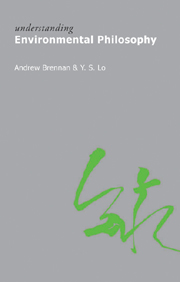Book contents
- Frontmatter
- Contents
- Acknowledgements
- 1 Introduction: the place of environmental philosophy and its basic concepts
- 2 Future generations: what consideration do we owe them?
- 3 Animals: are they as morally valuable as human beings?
- 4 Living things: ethics for the non-human world
- 5 Community: how big is our moral world?
- 6 Natural things: the puzzle of what “natural” means, and whether humans belong to nature
- 7 Foundations: can there be a secular basis for the ideas of human dignity and intrinsic value in nature?
- 8 Origins: political, religious and cultural diagnoses of environmental problems
- 9 Beyond individual responsibility: governance and the affluenzic society
- Questions for discussion and revision
- Further reading
- Bibliography
- Index
4 - Living things: ethics for the non-human world
- Frontmatter
- Contents
- Acknowledgements
- 1 Introduction: the place of environmental philosophy and its basic concepts
- 2 Future generations: what consideration do we owe them?
- 3 Animals: are they as morally valuable as human beings?
- 4 Living things: ethics for the non-human world
- 5 Community: how big is our moral world?
- 6 Natural things: the puzzle of what “natural” means, and whether humans belong to nature
- 7 Foundations: can there be a secular basis for the ideas of human dignity and intrinsic value in nature?
- 8 Origins: political, religious and cultural diagnoses of environmental problems
- 9 Beyond individual responsibility: governance and the affluenzic society
- Questions for discussion and revision
- Further reading
- Bibliography
- Index
Summary
Individuals, groups and communities
Once the moral circle is expanded to incorporate living beings apart from humans and animals, things get much more intriguing. For not all that lives is individual: termite nests and bee colonies have similarities to individuals in some ways, but at the same time are made up of many individual animals that form a highly organized group or system. Animal and plant populations are holistic, group entities rather than individuals, although again they can be treated – from some points of view – as very large organisms, themselves nested within even larger super organisms. Because of the importance of the idea of groups, communities and systems to contemporary environmental philosophy, we shall devote Chapter 5 to them, concentrating here on the extension of moral consideration to individual plants and other living things.
By treating questions about future generations, animals, individual living things and finally systems as separate matters, philosophy dismantles complexes of attitudes that in the real world are often grouped together. Many people already do think of non-human things as having a significant moral status, yet they do not always separate out their worries about future generations from their care about living things in general. Environmental protesters often talk about the need to protect future generations of people, or even to protect property. Greenpeace activists climbed the 200-metre high chimney of Kingsnorth power station in the UK in 2007 to paint a protest slogan, resulting in £30,000 of damage.
- Type
- Chapter
- Information
- Understanding Environmental Philosophy , pp. 67 - 86Publisher: Acumen PublishingPrint publication year: 2010



